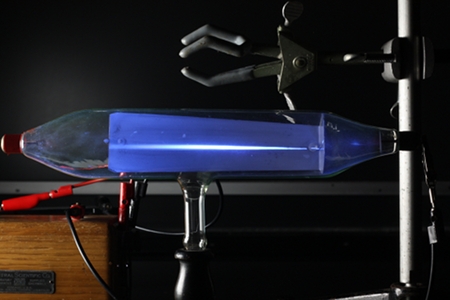What it shows:
A collimated beam of Cathode rays can be deflected by a magnetic field.


How it works:
This Crookes tube has an anode and cathode at opposite ends of a cylindrical tube, with a horizontal slit near the cathode and a vertical fluorescent screen running the length to the anode (see figure 1). The shape of the beam and the inclination of the screen means that the path of the electrons impinges on the screen and can be seen for the length of the tube. Moving the magnet in from behind the screen deflects the beam up or down; moving the magnet in from the top deflects the beam away from or into the screen.
figure 1. Crookes tube showing fluorescent screen and cathode aperture
Setting it up:
Please use gloves and safety glasses when handling this fragile vacuum tube. This Crookes tube uses the same power supply and induction coil as the Maltese Cross tube, and the same Alnico magnet for deflecting the beam.
Comments:
The fluorescent screen is ideally suited for electrons and renders a very bright image of the path of the cathode rays. Very visible even in large lecture halls; it doesn't need any additional aids.